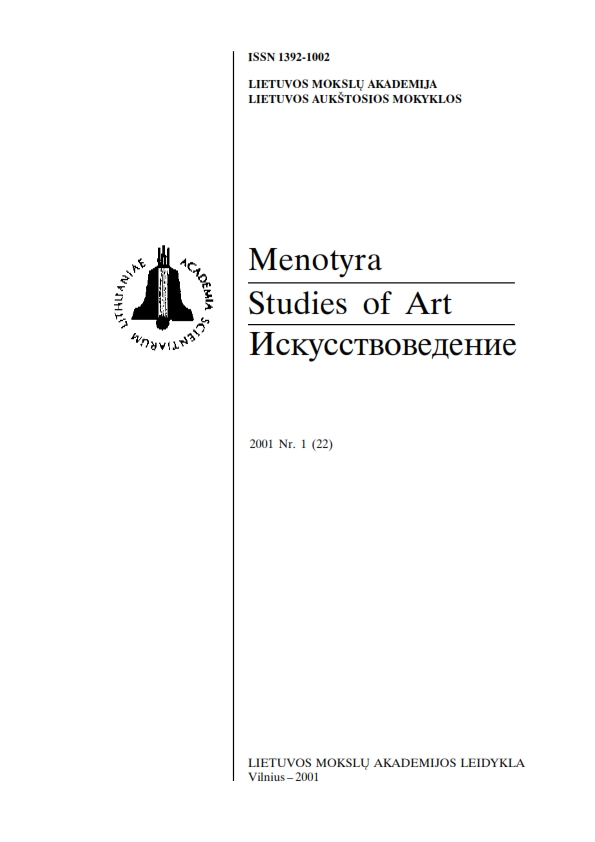Kazimiera Kymantaitė - nacionalinės dramaturgijos puoselėtoja
Kazimiera Kymantaitė: a fosterer of the original dramaturgy
Author(s): Audronė GirdzijauskaitėSubject(s): Theatre, Dance, Performing Arts
Published by: Lietuvos mokslų akademijos leidykla
Summary/Abstract: Kazimiera Kymantaitė seems to be one of the most outstanding personalities in the Lithuanian theatre. The original way of thinking, lifestyle and appearance made her different from others who tended to conform to the majority. The same applies to her performances which were not always a success (for various reasons) but nevertheless distinctive. The one way or another, she left a profound imprint on the history of the Lithuanian professional theatre.Kazimiera Kymantaitė was a pupil of one of the most renowned Lithuanian directors, theatre reformist Andrius Oleka-Žilinskas. Initially she began her career as an actress appearing in performances directed by her teacher as well as Borisas Dauguvietis and Romualdas Juknevicius at the State and Vilnius Drama theatres. In post-war years, the unfortunate circumstances (Dauguvietis' early death and, shortly afterward, Juknevicius' forced 'exile' to Telšiai) turned to be conducive towards her new career as a director, the more so as she has been concerned with the directing for quite a while. At the time she staged Žaldokynė by Borisas Dauguvietis and Marti dramatized by Viktoras Miliūnas. Then followed her collaboration with Aldona Liobytė in Žemė maitintoja and Meisteris ir sūnus by Petras Cvirka. After that she devoted her main artistic energies to dramatization and direction of the plays by Lithuanian authors of (by then) the youngest generation - such as Justinas Marcinkevičius (Kraujas ir pelenai), Kazys Saja, and Vytautas Rimkevičius (Paskolinkit ašarų) - and the classics such as Gabrielius Ladsbergis-Žemkalnis (Blinda), Balys Sruoga (Milžino paunksmė), and Kazys Inčiūra (Gulbės giesmė) as well as other plays, thus forming an enormous repertory of Lithuanian works still unparalleled up to this day. It is, however, important to stress that behind her great merits there was always a vocation, a moral obligation. She fostered Lithuanian dramaturgy at the time which was particularly unfavourable to promotion of Lithuanian national ideas.The choice of works for dramatization was in all likelihood suggested by the calling of her heart. Together with Aldona Liobytė and alone she dramatized pieces of Lithuanian literature. This had a many-sided effect on her personality: she became a mature individual radiating passion for classical works in her theatre and together with her actors attempting at creative reflection of nation's life, its outlook, character, hardships and hopes in her performances. She knew how to work with actors. Many of them created their best roles under her direction. Promoting Lithuanian national ideas and following her vocation, Kymantaitė created her own theatre within the theatre, as it were. It may be otherwise described as people's theatre within the professional theatre. This people hood was expressed in different ways affecting the choice of a repertoire and the manner of direction (it often led to the epic composition of a performance, exposure of the typical in favour of the individual traits of a character, exaggeration of situations, and the like). A title-holder of the People's Artist of the Soviet Union, Kymantaitė used to claim that she was the people's artist indeed.To end up with, it is worth saying that Kazimiera Kymantaitė was quite an odd chip off her old teacher's block... The traits of their creative work are completely different, with one notable exception, that is, their vocation, calling, absolute devotion to the Theatre.
Journal: Menotyra
- Issue Year: 2001
- Issue No: 1(22)
- Page Range: 13-18
- Page Count: 6
- Language: Lithuanian

